Glass kitchen aprons are a great alternative to tile
Glass is a great alternative ceramic tiles and other materials that are traditionally used to finish the apron, that is, the section of the wall above the working area of \u200b\u200bthe kitchen. It is one of the most environmentally friendly and hygienic finishing materials. The glass apron is not afraid of moisture and steam, does not absorb dirt and grease, is easy to clean and looks incredibly impressive.
How to choose the right apron for the glass kitchen, 6 of the most common mistakes when ordering and the nuances of installing glass panels, an overview of prices, designer's advice, photos of kitchens from skins and reviews of glass aprons - here.
Quick article navigation:
The most popular myth about glass aprons is on shiny surface glass will be too visible drops of water and grease, dust, fingerprints. However, according to the reviews of those who have already decided to make such an apron in the kitchen, there are no more marks on it than on other surfaces, for example, on ceramic tiles. And it is much easier to care for him - glass does not have tile joints where contaminants accumulate over time.
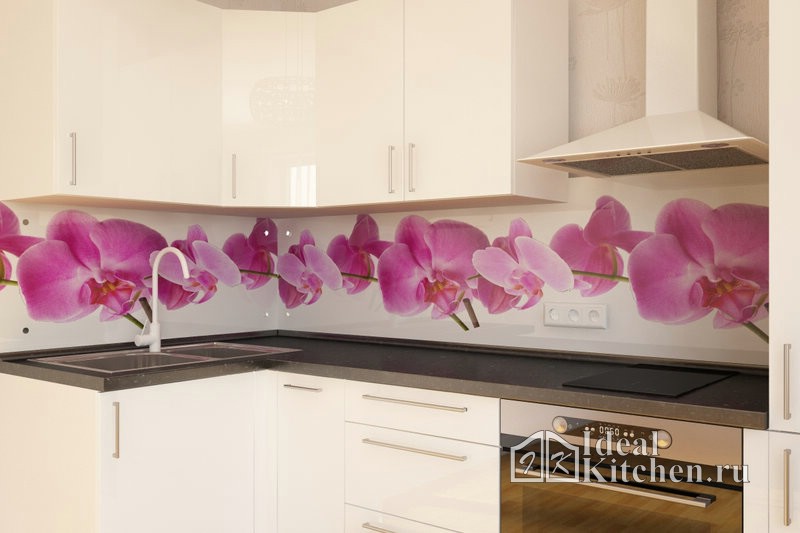
What kind of glass is suitable for an apron?
As a rule, the thickness of glass for a kitchen apron is 6 or 8 millimeters.
Tempered glass is 5 times stronger than ordinary glass. But even if somehow it manages to break, its fragments will be small and not sharp.
Such an apron is perfectly adjacent to the stove or hob and is not afraid of exposure to heat.
Ordinary glass is less reliable. Plexiglas apron is generally difficult to consider as an option for wall decoration in the kitchen. It cannot be used in the area gas stove due to temperature fluctuations, plexiglass is easily scratched, tarnishes, and is poorly cleaned of grease and other kitchen contaminants.
When choosing glass for an apron, keep in mind: you may need the so-called discolored glass - Optiwhite. Ordinary glass, although it seems absolutely transparent, actually has a pronounced greenish “bottle” tint. On colored aprons (with a landscape, a city panorama or a multi-colored still life), it will be invisible. But if your apron has a lot of white or another very light background, a greenish tint will ruin everything.
Experts note that due to the greater transparency, Optiwhite makes the pattern on the apron clearer and brighter. Clarified glass costs about 30% more than regular glass.
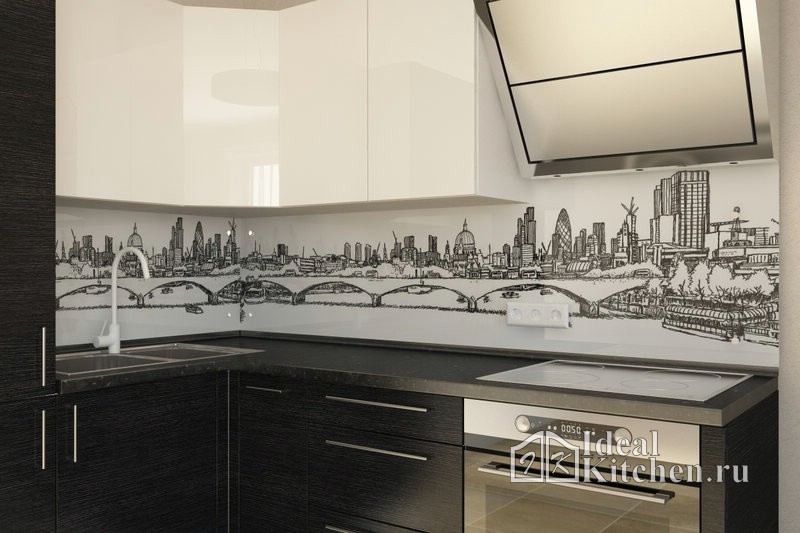
What can be a glass apron?
1. Bes colored glass without color pattern
It is transparent or frosted. Dignity transparent apron in the fact that he is “invisible”, does not catch the eye at all and seems to dissolve in space. Its main function is to protect a wall painted with paint or pasted over with wallpaper (photo wallpaper) from splashes.
The frosted glass apron gives less glare and looks more interesting.
Glass does not have to be smooth. Panels with a textured textured surface, for example, satin, look very nice.
Another option is with sandblasting or silk-screen printing on the surface of the glass, you can apply a picture, ornament or inscriptions.
2. Photo printing (full color UV printing) on glass
Panels with a beautiful image printed on them were called skinali. Today it is the most popular and sought-after version of the glass apron.
The glass apron with photo printing is very beautiful and durable. The image is applied to the "wrong" side of the glass using special technology. UV ink does not fade, withstand heat up to 120 degrees, are not afraid of moisture.
Panels with 3D effect look especially impressive. However, such an apron will cost much more than colorless or painted glass.
3. Painted glass
Solid color glass apron looks very stylish, bright and at the same time unobtrusive. The palette of available shades without exaggeration is huge.
In the manufacture of such aprons, the so-called stemalite can be used. On the inner surface glass panel applied special paint, then the glass is heat treated. This is a very reliable and durable method of staining.
4. Patterned on decorative vinyl
A kitchen apron with a vinyl film on which a drawing is applied is a more budgetary and affordable option than photo printing. The film is rolled onto the inner surface of the glass, which protects it from moisture and temperature changes. However, over time, it can wrinkle, flake and burn out if the material and work were of poor quality.
5. Triplex tempered glass apron
Triplex is called laminated glass of different thicknesses. Its advantage is that the drawing is reliably protected from any external influences. A triplex apron is a "sandwich" of two layers of glass, between which the image is "baked". If suddenly the triplex can be broken, it will not break, but will simply be covered with cracks. However, this option in the kitchen is used quite rarely. The reason is the relative high cost, its thickness is greater than that of a conventional glass apron, and there are some inconveniences with cutouts for sockets and roof rails.
6. Mirror apron
It looks very stylish and unusual, visually expands the space and creates an unusual visual effect. But many people are very uncomfortable with constantly seeing themselves in the mirror while cooking or washing dishes. Therefore, instead of mirror panel better use mirror tiles with sandblasted finish and partial matting.
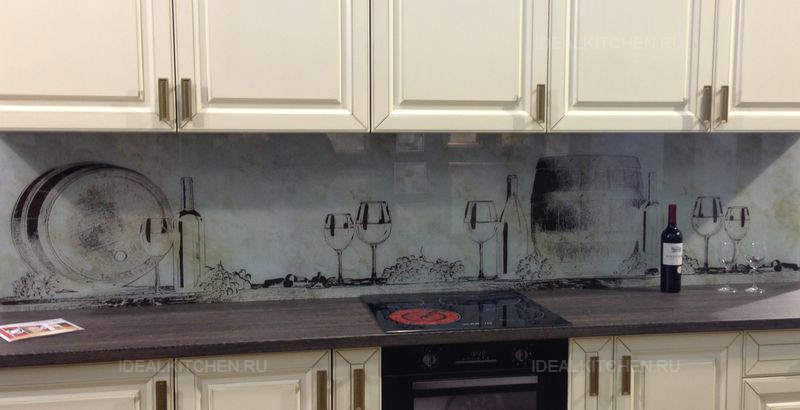
From the designer
A glass apron is very good for a cramped and small kitchen. Unobtrusively reflecting the surrounding objects, it visually expands the space. Glossy surface such an apron reflects light and makes it lighter.
A landscape or a picture with a view of the city adds perspective, depth to space, pushes the boundaries - exactly what you need for a small-sized kitchen.
High-quality glass panels made by technology are very durable. Such an apron will definitely serve you at least until the next overhaul kitchens.
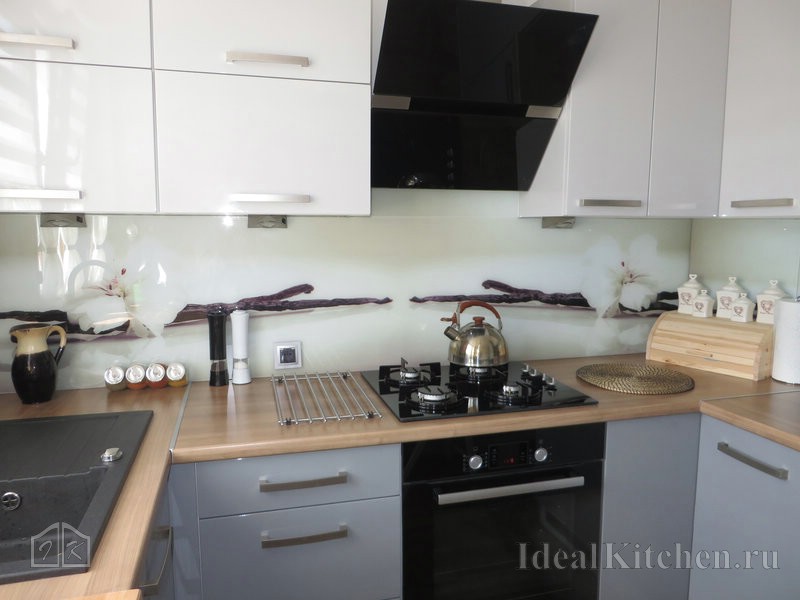
Installation of a glass apron - important nuances
Installing the finished apron takes very little time. Average per standard apron experienced craftsmen it takes 1-2 hours.
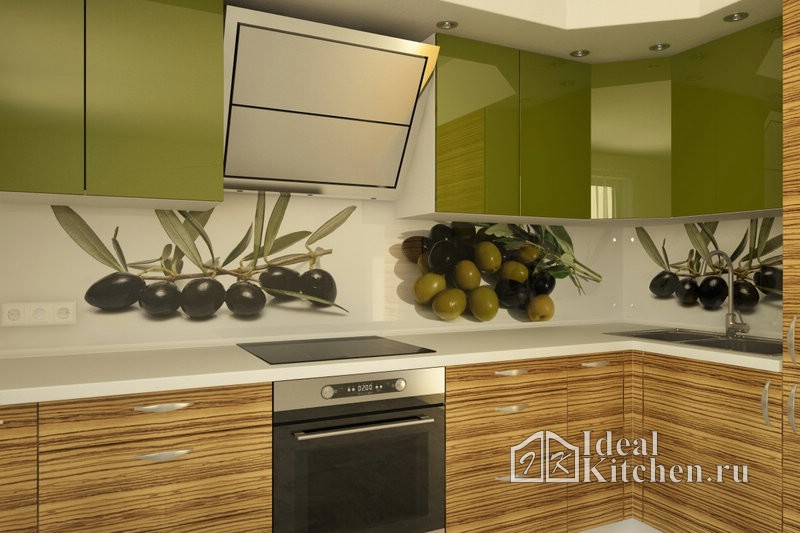
The speed and cleanliness of installation favorably distinguishes skinali from or mosaics.
The glass apron is attached to the wall in two ways.
1. With fastener
This method of installation is considered optimal. The apron is fixed very securely, even if the glass is thick and heavy. Another plus - with this method of fastening, you do not need to carefully prepare and level the wall. In addition, if necessary, the apron can be easily dismantled and put back.
Please note: two types of fasteners can be used - hinged or through.
Hinged fasteners- these are metal plates - "hooks" the size of a centimeter, into which a glass panel is inserted. There are no holes in the apron. The plates press the glass and are very subtle. This mounting method allows you to most accurately join the edges of the panels if the apron is not solid.
Using through fastener before tempering the glass, special holes are made in the corners of the apron for screws. After installation, they are closed with special decorative caps with a diameter of 2 cm.
The advantage of this method is that there is a gap of about 4 mm between the glass and the wall. Therefore, such aprons can be mounted even on very uneven wall or, for example, on old tile. But fasteners will always be in sight, and they will not fit every design.

2. On glue or liquid nails
With this method, the glass panel of the apron is glued to the wall. It is very important that the wall is properly prepared. The surface must be leveled, plastered and dry. Installation was skinned with glue on one side easier - no need to drill walls and fiddle with fasteners. On the other hand, the use of fasteners is considered more reliable.
After mounting the glass panel, the joint between the apron and the countertop is closed with a wall ledge. If the apron is not solid, but composite and there are joints, it is very important that the master carefully aligns the panels without leaving gaps. Joints are processed silicone sealant which protects the wall from fungus. The thinnest layer sealant with outside at neat work the master will be invisible.
The standard installation offered by Moscow companies does not include preliminary training walls and installation of fittings and accessories (skirting boards, roof rails, sockets, lights, etc.) These services will have to be paid extra.
If desired, the installation of a glass apron can be done independently. But this work requires experience and skill in handling glass.
![]()
Dimensions
The standard height of the kitchen apron, as a rule, is from 40 to 90 centimeters. According to experts, it is desirable that the length of the glass panel is no more than 2-2.5 meters. If you have big kitchen, and you need a long apron, they will make it composite. At the same time, the joints with high-quality work are almost invisible.
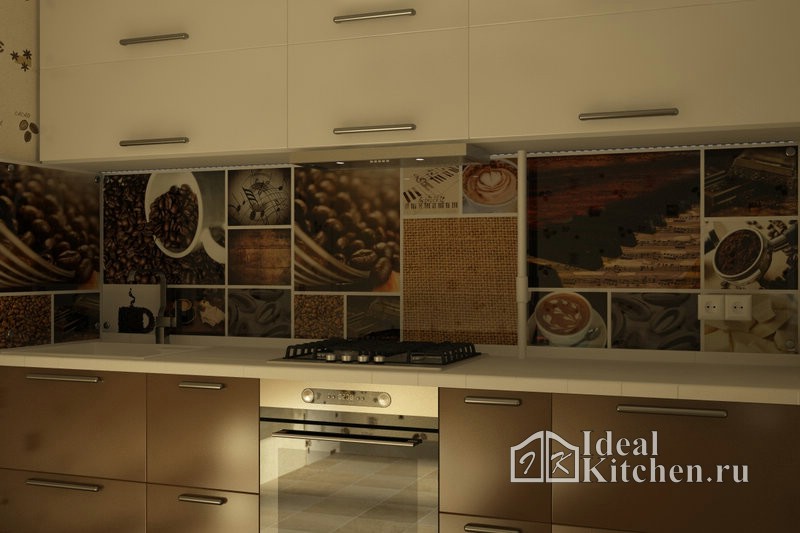
How much does a glass apron cost?
Prices for a glass apron, even in Moscow, not to mention the regions, can differ very much. How much will it cost ready product depends on many factors: the type of glass, the method of coloring and applying the image, the method of installation and the cost of fasteners, is it a composite or one-piece apron, whether there are beveled corners in the working area, whether additional design refinement of the image is needed, etc.
The editor of the site studied the price lists on the sites of a couple of dozen Moscow companies that manufacture custom-made glass aprons, which made it possible to get some idea of the services and the general price level.
The departure of a measurer in Moscow costs about 1000 rubles, in the region - about one and a half times more expensive.
On some sites, you can use a calculator that allows you to get a preliminary calculation of the cost of a future apron. The price, of course, will turn out to be very approximate and can easily change with a real order.
We tried to calculate the cost of an apron made of tempered glass with photo printing 250 cm long and 60 cm high with cutouts for two blocks of sockets and roof rails. Three calculators promised that such an apron would cost about 14 thousand rubles. This price includes measurement, the cost of manufacturing an apron, delivery within the Moscow Ring Road and installation.
If clarified Optiwhite glass is used, then the price of exactly the same apron rises to 17.5-18 thousand rubles.
On average, prices for a 6 mm tempered glass apron with UV photo printing start at 4.5-5 thousand per square meter including the cost of fasteners.
An apron with photo printing with a 3D effect will cost from 9.5 thousand rubles per meter.
The minimum price for a transparent tempered glass apron 6mm without photo printing starts from 3.5 thousand rubles. The same apron, but made of transparent Optiwhite glass, will cost about 30% more.
Strained glass 40-50% more expensive than ordinary silicate "raw" glass.
If you choose a triplex with photo printing, then prices start at 10.5 thousand per square meter.
The average production time for a glass apron is 10-15 business days.
Keep in mind that there are a number of services that you may have to pay extra.
These include trying on an apron, a color proof, a color proof, additional design processing of a drawing and the creation of an individual layout. Some companies charge a fee to purchase an image from a photo bank. Many manufacturers offer to additionally protect the surface of the apron with a transparent or colored protective film. For some, this service is free, for others - from 500 rubles per linear meter.
A virtual fitting of three variants of aprons in the photo of your kitchen within the Moscow Ring Road costs 900-1000 rubles. Some companies when placing an order are taken to do it for free.
Examples of how a glass apron can look on real kitchen see our photo gallery:
Photos of aprons from manufacturers
What can be a glass apron for the kitchen? What is the price of 1 sq. m. finishing material? Is such a finish worth the cost and time incurred, or is it better to use traditional options design working wall? How to install a glass backsplash for the kitchen? Let's answer all these questions in detail.
- Kitchen apron - part of the wall between the countertop, stove, sink and hinged kitchen cabinets. The apron is finished with a material that is resistant to dirt and temperature extremes.
- A glass apron is made from ordinary, quartz, silicate glass, in rare cases, from plexiglass, but this is an impractical option: plexiglass is easily scratched, darkens over time, and is difficult to clean from grease stains.
- Basically, a glass backsplash is made with photo printing or mirrored, smoked glass, so that the wall does not shine through the kitchen panel. Photo printing is done with inside glass, the front surface is smooth and durable.
Glass apron in the kitchen
The thickness of the glass apron is at least 6 mm, because thin glass very fragile, easily beats and shatters into fragments. The maximum thickness of glass that can be used is 10 mm. A glass apron with a thickness of 10 mm is used in cases where enough big square walls. Such an apron is attached to through fasteners, not to liquid nails.
- Glass tinting hides the wall and fasteners. You can place an opaque smooth screen behind the glass and the issue will be removed.
- For the apron, mirror glass with amalgam and polarized glass are used, reflecting most of the incoming UV rays. The use of an opaque screen behind glass in such a situation is also relevant, because a sufficiently bright lamp next to the apron will show the working wall through the glass.
- Painted glass. The paint of the selected shade is evenly distributed on the back surface of the glass panel, the front surface retains its glossy appearance.
- Glass apron with photo printing. On the back surface, at the individual choice of the customer, a pattern, an abstract picture, an image from the catalog offered by the manufacturer, a personal or any other photograph is applied. Flowers, a glowing city at night, a sky with beautiful clouds, mountain peaks - everything that will please your eye.
- Triplex. These are 2 sheets of glass, between which a film with a picture or a photograph is pasted. In this design, the pattern is not threatened even by a temperature difference near hob. The image will not peel off due to the fact that it and glass have different coefficients of thermal expansion. From exposure sun rays And environment The film is protected much more effectively.
- Glass apron with backlight. Lamps are installed at the ends, provoking the entire volume of the image to glow. The effect is very unexpected for the kitchen.

Triplex with an image between the panes
tempered glass kitchen apron
Tempered glass increases impact strength by 5-7 times compared to ordinary glass. The apron is almost impossible to break. If this situation does happen, there are no small fragments, the risk of injury will be reduced several times.
Installing a glass apron for the kitchen
Usually, the installation of a glass apron is not included in the cost of the panel, and its delivery requires careful and careful handling and is also paid separately. But in the construction services market there are manufacturers who provide comprehensive services for the manufacture, delivery and installation.

The modular system is the most fast way install a glass apron in the kitchen.
Methods for attaching the apron to the wall
- On a leveled surface with glue ( liquid nails). slight bend working surface allowed. Most thick glass does not lose its flexibility, of course, within acceptable limits.
- edging decorative profile. Attached to the wall with dowels decorative frame. At the top, the profile is not fixed, it is held due to its own weight. If you are doing the installation yourself, do not use wooden chopsticks under the dowels, only plastic. In the kitchen, the humidity of the air is constantly changing, which can provoke the destruction of the tree (it will dry out), the mount will lose its reliability. IN construction stores ready-made kits for fastening kitchen aprons are sold.
- Fastening glass aprons with screws wide hats. The screw is screwed through the holes in the panel. Elementary and popular method, not required preliminary alignment walls. It is not necessary to strongly attract the panel to the working wall; use plastic or rubber insert washers.
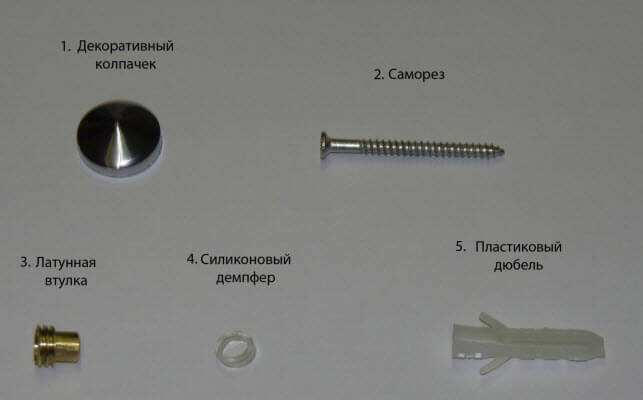
Installation of a glass apron using fasteners (through drilling)
How much is a glass apron for the kitchen
The price for the same version of a glass kitchen backsplash may vary depending on the territory of the Russian Federation where the glass panel is made. Below are the average prices for manufacturing and installation in our country as a whole.
- The minimum cost of a glass kitchen apron, which is presented on the websites of manufacturing companies, is 2000 rubles per 1 sq.m. The apron will be made of thick glass, the edges will be processed, the size of the panel is on order.
- The use of tempered glass increases the cost by 1.5-2 times. A glass panel of 2.5 x 0.6 meters will cost the buyer from 4,000 to 9,000 rubles. The cost is determined by the thickness of the glass and the color shade.
- The cost of a glass apron with photo printing varies in a fairly wide range. A panel with an image chosen by the buyer will cost from 6,000 to 15,000 rubles per 1 sq. m.
Price list
Advantages and disadvantages of glass panels
Consider the advantages and disadvantages of glass aprons.
Advantages of a glass apron
- Glass is a non-hygroscopic material, completely devoid of large pores. Dirt and dust cannot accumulate in the thickness of the panel, only on the surface itself. ingrained greasy spots on the surface are completely excluded.
- It is acceptable to wash the surface with any cleaning or detergents, including abrasive powder, acid solution, steel wool. Glass belongs to a chemically resistant material, it is almost impossible to leave scratches on the glass, especially if the panel is made of tempered glass.
- The one-piece glass panel relieves the housewife of the need to care for joints in which dirt, dust, and grease accumulate. The surface is completely flat. If the apron was made on your own, then side seams cannot be avoided, as a rule, the panel consists of two or three pieces.
- Appearance of the apron highest level. The space visually increases due to the glossy surface, the illusion of depth appears. The kitchen looks bigger than it really is.
- Long service life. The only situation that puts the panel out of service is a powerful blow with a heavy object on the surface of the apron.
- Fast installation. If through fasteners are used, installation takes no more than an hour.
- Spacers for fixing are not needed, they are only needed if the panel is mounted on an adhesive that needs time to set.
- Competitive prices, even if we consider a glass apron with photo printing. If the apron is made by hand, the cost in the end is minimal. It cannot be compared with the cost of laying even the simplest tile.
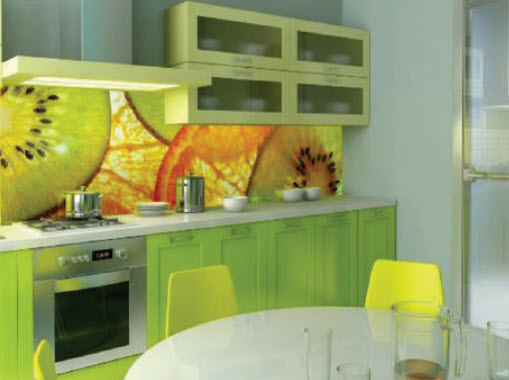
Cons of glass aprons
The disadvantages are so minor that the buyer is likely to abandon the search alternative solution issue with the design of the working surface of the wall. But they still exist, let's deal with them:
- Bring in the finished glass panel 2.5 x 0.6 m difficult task, which is practically unsolvable for small apartments, such as Khrushchev, which have small flights of stairs. But in houses with large flights of stairs, the size of the kitchens is correspondingly larger, which also causes problems. If the apron is assembled from fragments, it will not be possible to avoid side seams, the aesthetics are violated, extra work seam care.
- The risk of hitting the surface of the panel is still present. If the wall is tiled, then it will be enough to replace 1-2 tiles, in the case of a glass apron, the entire panel is replaced.

Conclusion
A glass backsplash is an optimal and worthy solution in the design of a working wall in the kitchen. Maintaining a glass apron in a presentable form is not difficult. glass panels will create a visual effect of increased space in your kitchen.
To date, there are many different finishing materials for the kitchen, but recently glass has become widespread. With it, you can create a very colorful kitchen apron, which is one of the most important components of the kitchen interior.
The glass backsplash for the kitchen is made from the most environmentally friendly clean materials. In addition, it is resistant to temperature extremes, high humidity and easy to care for.
Which glass should be chosen for a glass apron
First of all, you need to know that the thickness of the apron should be in the range of 6 to 8 millimeters. If it is located in the working area of the kitchen, then only tempered glass should be used.
Important ! You should not choose ordinary glass or plexiglass for a glass apron, as they are not as reliable as tempered ones. Plexiglas does not withstand temperature extremes well, tarnishes quickly and is difficult to clean from various kinds pollution.
Types of glass apron
One of the main features of a transparent apron is that it harmonizes well with the interior, while not being too conspicuous. It is designed to protect the painted or wallpapered surface from contamination.
To date, this type of apron is the most popular. Its main characteristic feature is its increased service life and excellent appearance.
Photo printing is applied to the back of the apron. Characteristic features UV photo printing is that it is resistant to high levels of moisture, can withstand temperatures up to 120 degrees Celsius and does not fade.

Glass is dyed solid color what makes such an apron stylish accent in the kitchen interior. You can choose absolutely any color for glass, the range of colors is extensive and able to satisfy any taste.

This version of the glass apron is the most budgetary. Vinyl film applied to the back glass surface, and it, in turn, protects the film from contamination, high humidity and temperature.
But this type has its own negative side. During operation vinyl film may fade or shrink. In most cases, this is due to the fault of poor-quality material during the production process.
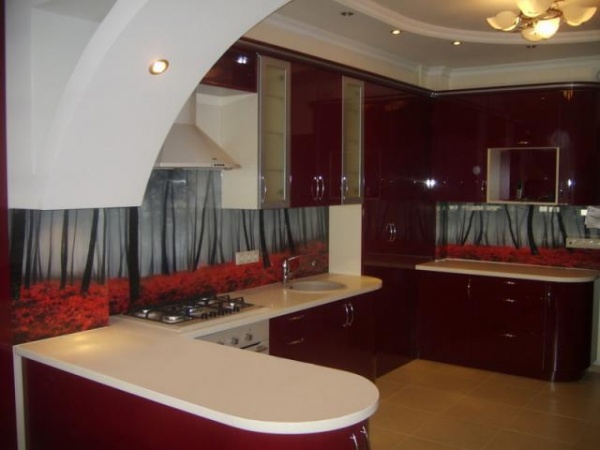
This type of apron is the most expensive model of all presented. Triplex is laminated glass with different thickness, which is the most durable and reliable option. It reliably protects the applied pattern from temperature changes, high humidity and pollution.
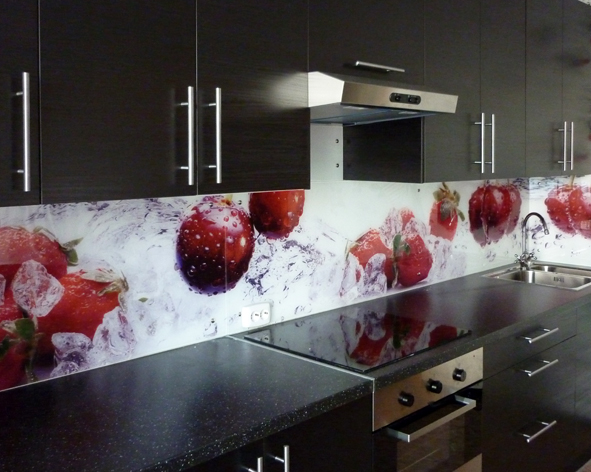
A stylish solution that will become an unusual accent in the interior of the kitchen. Apron from mirror glass will look great in relatively small kitchen, visually expanding its space.
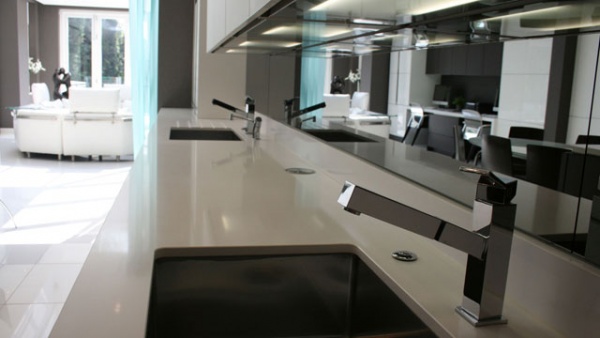
The white kitchen has become a kind of classic that remains relevant today. A glass apron, which can become its brightest detail, will help to complement the interior of a white kitchen.
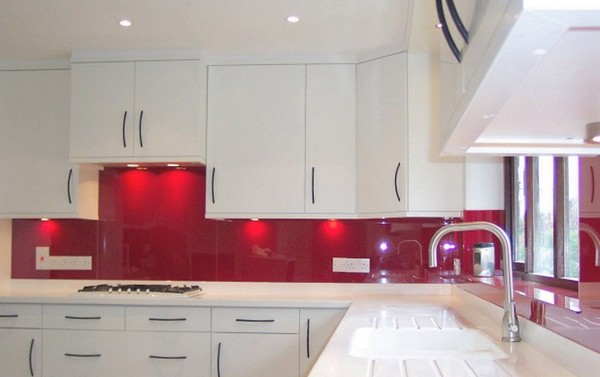
Which apron is suitable for a white kitchen
- The color can be any, as white goes well with any color solution;
- If the kitchen has cold shade white, it is best to choose an apron in blue or green;
- For a kitchen with warm shade white, perfect apron bright colors, pink or purple;
- If the apron is decorated with a pattern, then you need to choose a pattern that will be in harmony with the interior of the kitchen.
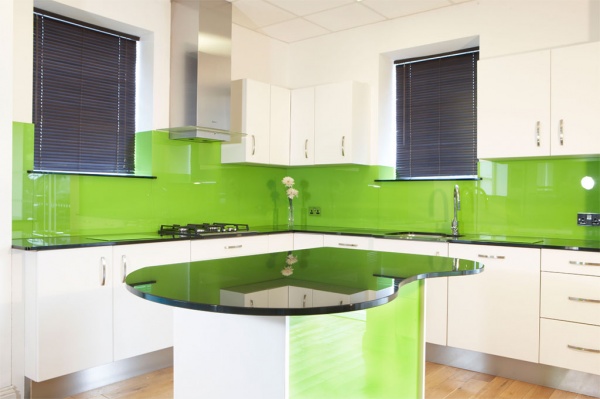
A backlit glass apron is an excellent detail in the interior of the kitchen. For him, you can choose any pattern or paint it in any color scheme, and also complement it with a highlight.
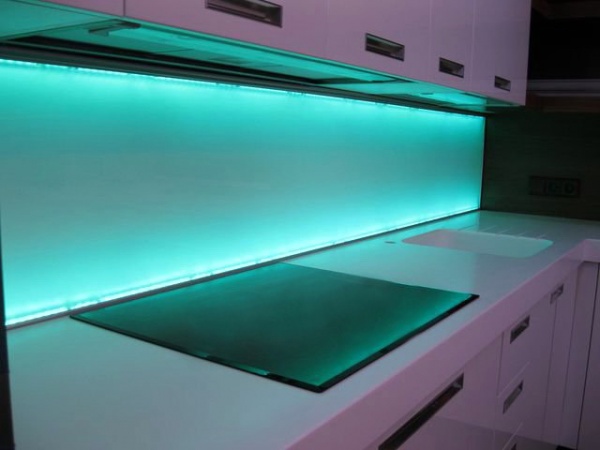
The purpose of the backlit glass apron
- A backlit glass kitchen apron will help make the interior of the kitchen more interesting and stylish;
- It can become not only an element of decor, but also an additional source of lighting, which is a definite plus.
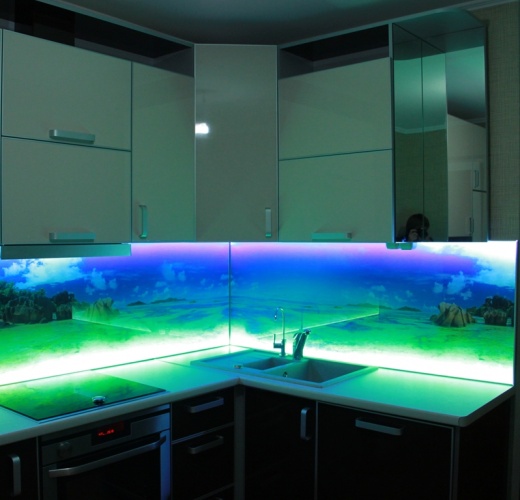
The advantage of backlit glass apron
- Firstly, the advantage of such an apron is increased performance characteristics glass;
- Secondly, it is safety. If it falls, there will be no sharp fragments when it falls;
- Thirdly, it is easily cleaned from various kinds of pollution;
The cost of a backlit kitchen apron
The cost of a backlit kitchen apron will directly depend on the following points:
- Glass processing technology (clear or frosted glass, colored glass, ultraviolet photo printing, drawing, etc.);
- Illumination type (LED-illumination or LED Strip Light);
- The complexity of installation;
- Type and method of attachment.
From the above points, the final cost of the illuminated apron will be formed.
Advantages of a glass apron
- Today you can buy a glass apron at a low price;
- Relative ease of installation. The glass apron can be fixed with liquid nails or special fasteners;
- The design can satisfy every taste. You can choose absolutely any pattern or color scheme;
- The glass apron can become great addition to the interior of the kitchen. Its appearance can be made in the color of the headset or in the color of the walls;
- It is also durable and reliable. Able to protect the surface of the wall from impacts external factors, whether high humidity or temperature fluctuations
- The apron is easy to clean.

Cons of a glass apron
- Measurements must be taken very carefully. If there are inaccuracies in the measurement process and the data are erroneous, it is very difficult to remake the glass after processing to the specified size. This threatens with unnecessary spending on reworking glass under right size;
- It is quite difficult to cut out suitable sockets for sockets, if any. This can significantly increase the final cost of the apron;
- If the installation process was performed with obvious violations, then with back side glass, condensation may form. Ultimately, this can ruin his appearance;
- If the surface on which the apron will subsequently be attached is uneven, then the glass may crack (this point must be taken into account in advance).
Rules and methods for mounting a glass apron
Installation of the apron does not take much time, representing a fairly easy process. On average, this can take 1-2 hours.
The glass apron is attached with:
- liquid nails;
- Clay;
- fasteners.
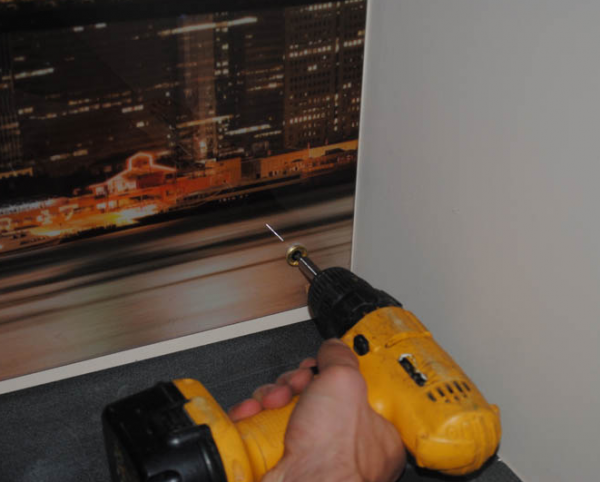
Mounting with fasteners
This method is the most popular. The advantage of this mount is that it is reliable and durable. At the same time, the apron is easy to dismantle if it is necessary to change or remove it.
Fasteners for a glass apron has several types: hinged and through passage.
Hinged fasteners
Hanging fasteners are small metal slats one centimeter in size, in which the glass surface is mounted. The advantage of hinged fasteners is that it can be used to accurately dock glass panels, for example, if the apron is large and consists of several parts. Another plus is that the fasteners are almost invisible.
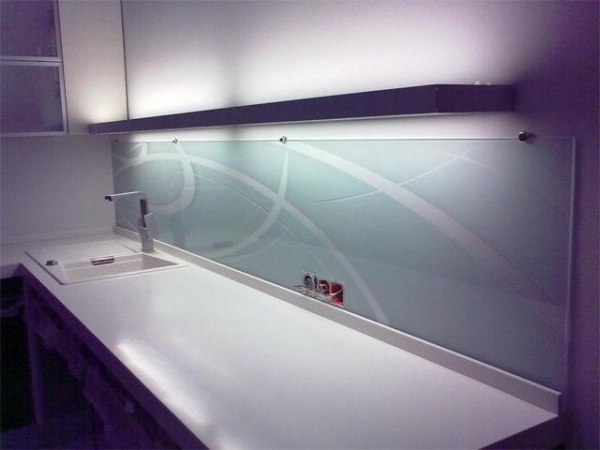
Through fastener
This fastener is located directly in the panels themselves. Small holes are made in the glass surface, where the fastener itself is inserted. The disadvantage of the through fastener is its visibility on the panel. But at the same time, through-hole fasteners have their own significant plus. The apron can be mounted on a relatively uneven wall, since a small gap of 4 millimeters remains between the wall and it.
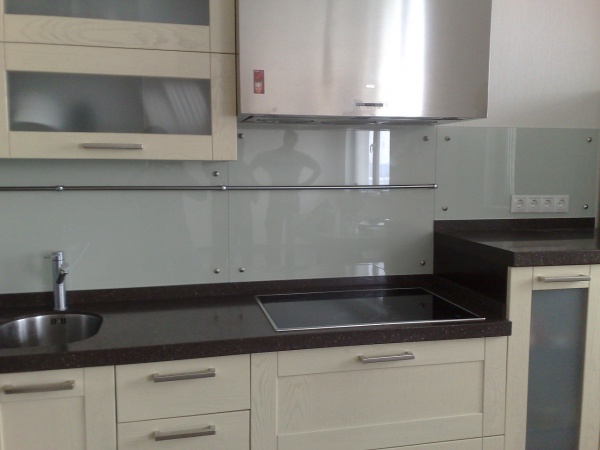
Installation with liquid nails or glue
When mounted with liquid nails or glue, the apron is glued directly to the wall. Here the main difficulty is that the wall must be prepared in advance and properly prepared for gluing. The surface on which the apron is subsequently to be attached must be perfectly plastered and leveled.
Installation with liquid nails or glue is not a difficult and fast process, but less reliable than with fasteners. If the apron consists of several panels, it is necessary to fit all its parts joint to joint so as not to leave gaps.
Prices for glass apron
The final cost of a glass apron will depend on the following factors:
- What kind of glass is used in the manufacture;
- Technology for drawing or painting;
- Mounting technology;
- Type and cost of fasteners;
- The number of panels it consists of.
These are the main factors on which the price of the product will subsequently depend.
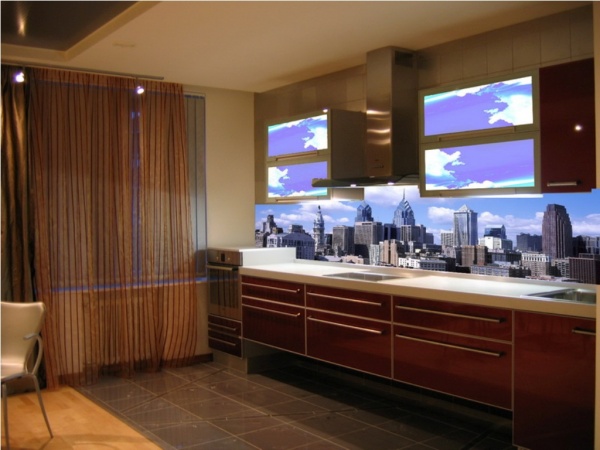
- First of all, the glass apron must be made of tempered glass. Tempered glass is able to withstand temperature changes and excessive moisture. If the apron is broken, then when broken, small fragments are formed without sharp edges;
- It is necessary to order only in reliable companies. If it is made from low-quality materials, then this will result in even greater spending;
- It is best to purchase a kitchen apron made of a solid glass panel, it will look the most aesthetically pleasing, since there are no joints;
- It is necessary to order a glass apron with a ready-made pattern. This is due to the fact that the paint used in production is applied using a special technology and is more resistant to external factors.
Glass apron for the kitchen can become great way giving the interior a special zest and sophistication. At the same time, the price for it is quite acceptable, thanks to which anyone can afford to install it.
And other materials. Glass has properties that make this material ideal for kitchen decoration.
Advantages of a glass apron
Installing a glass apron provides:
- beautiful appearance working area kitchens;
- a wide range of design solutions;
- the ability to install lighting and sockets;
- the ability to install and replace panels with your own hands.
The glass apron does not have joints that quickly become clogged with dirt. They are easy to clean, and the common belief that stains from dried water are more visible on glass is not true. A glass apron will transform your kitchen, make it smart and bright.
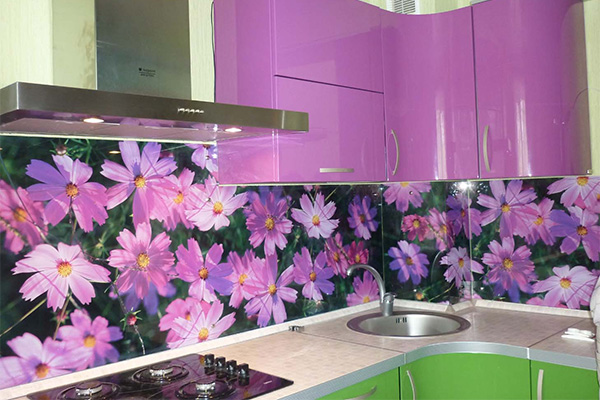
What kind of glass is suitable for an apron?
Glass advantages:
- does not absorb moisture and is not afraid of steam;
- is resistant to chemically active substances;
- does not change its properties over time;
- does not scratch.
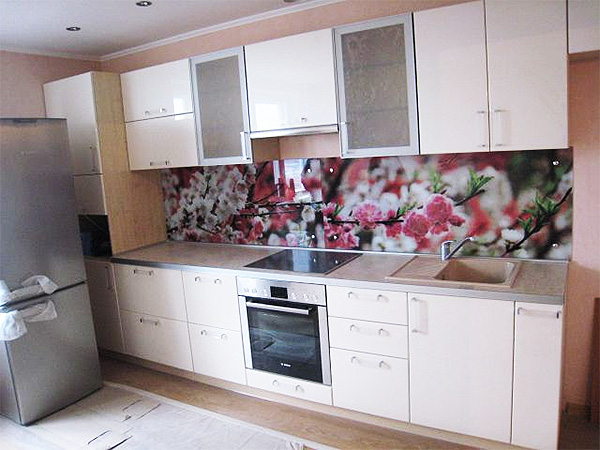
For kitchen panel Not all glass will work. It should be:
- thickness from 6 mm;
- hardened;
- discolored.
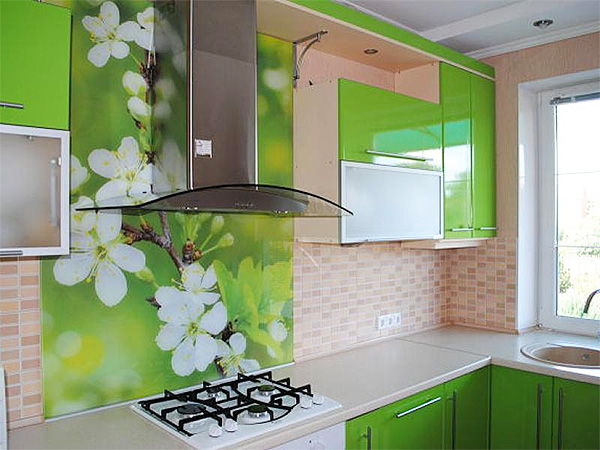
Tempered glass is not afraid of temperature changes, has great strength and practically does not break. If it is nevertheless broken, it shatters into small fragments with rounded edges.
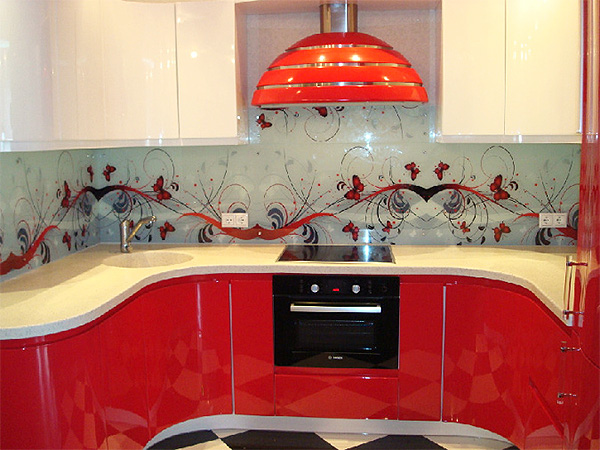
Ordinary glass has a greenish tint, noticeable on a light surface. Paintings of any tones look great on discolored glass. Depending on the design, matte or transparent panels are used.
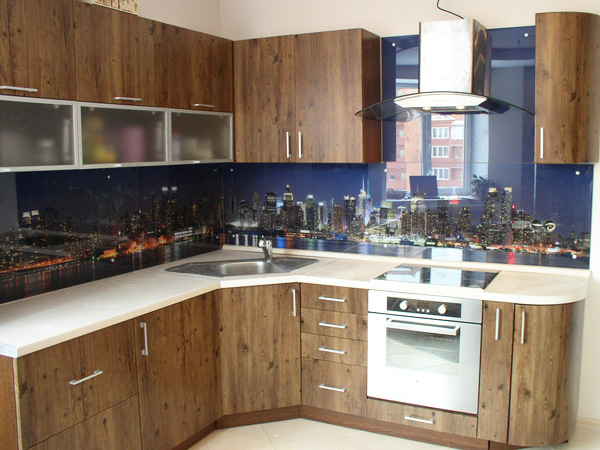
Organic glass is completely unsuitable. It scratches easily, melts when the temperature rises, and gradually tarnishes.
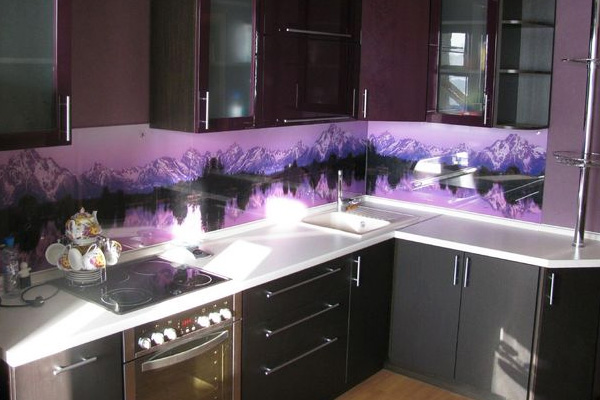
Dimensions
Usually the height of the apron is in the range of 40 - 90 cm. The height of the panel should be chosen so that its upper edge is hidden behind wall cabinets, and the lower one is behind the countertop. Sometimes the upper edges of the panels are attached to the underside of wall cabinets.
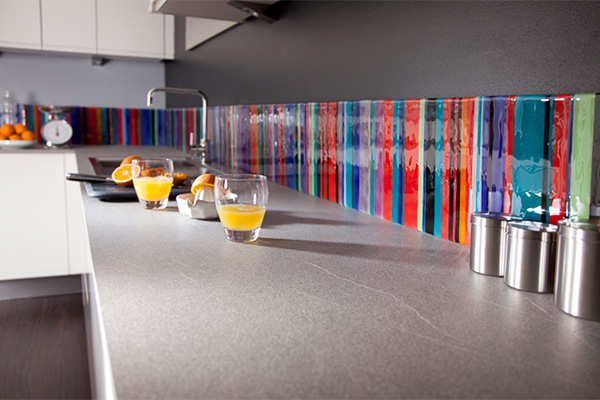
If the panel is located at some distance from the wall, its height should be chosen a few millimeters less than the distance between the cabinets and the worktop.
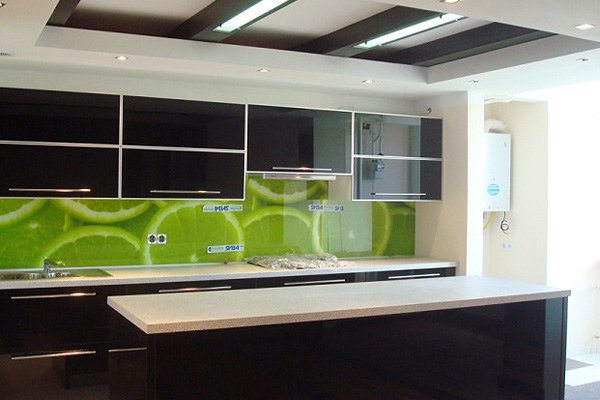
The length of one panel should not exceed 2.5 m. A longer apron is assembled from several panels. They try to make the seams between them invisible, but it is better to place them on the line of contact between adjacent wall cabinets.
Design of glass aprons
colorless glass
For panels without illumination, transparent glass is used. It does not stand out against the background of finishing materials and protects them from splashes and dirt.
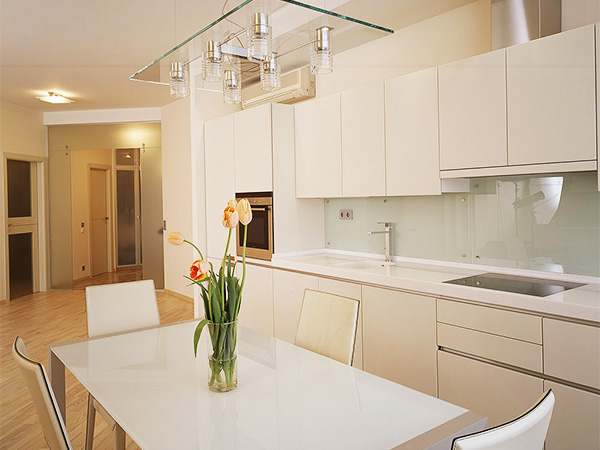
It is better to close the backlight with a matte panel, which scatters light and reduces eye fatigue.
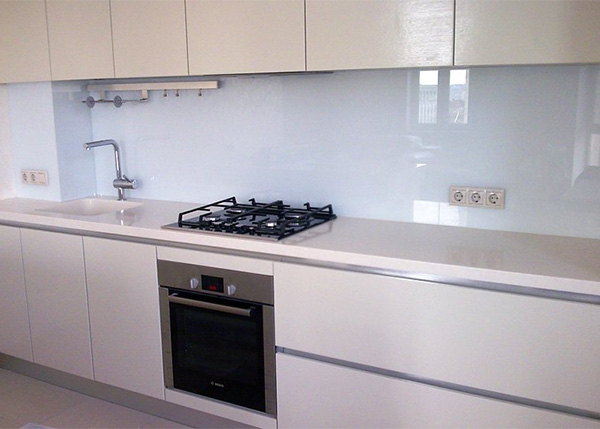
The surface can be flat or embossed. The embossed panel looks more interesting.
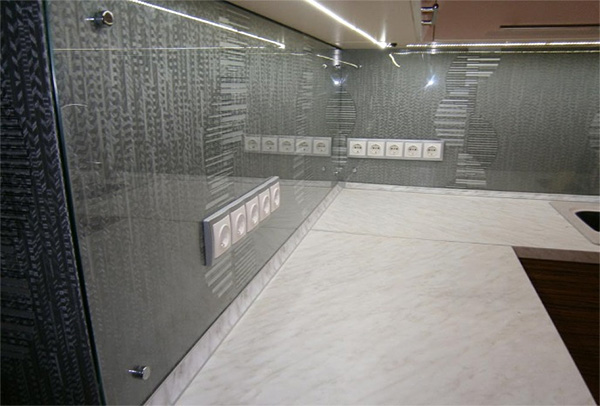
plain glass
Panel painted in one color to match the shades kitchen interior looks unique and attractive.
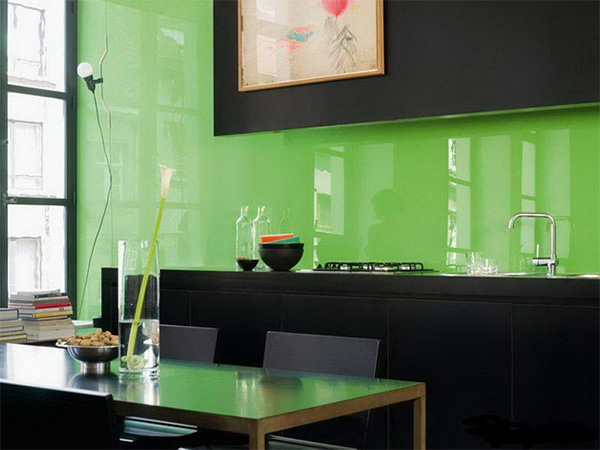
To keep the paint for a long time, the painted glass is heat-treated. You should know that the backlight through the color panel will also be colored.

Drawing on vinyl film
A film with a pattern is glued to reverse side apron. This is the easiest way to apply a pattern, but the film may wrinkle or peel off over time, and the pattern may burn out. In backlit panels, the film loses its appearance quickly enough.
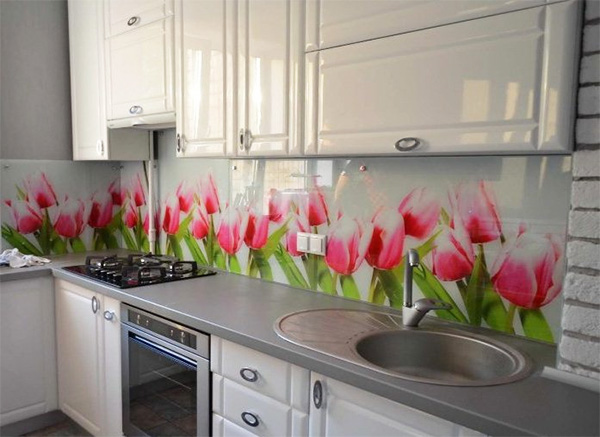
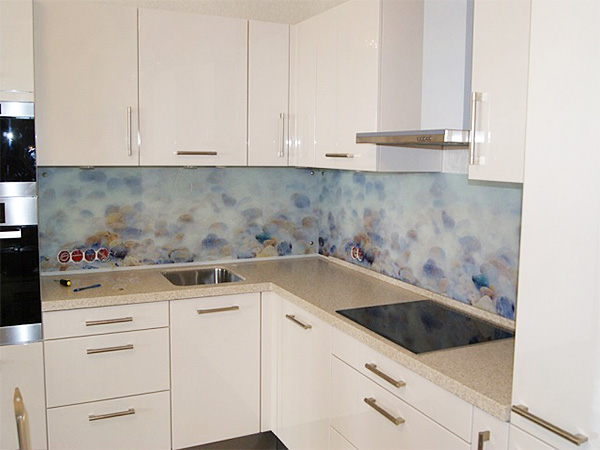
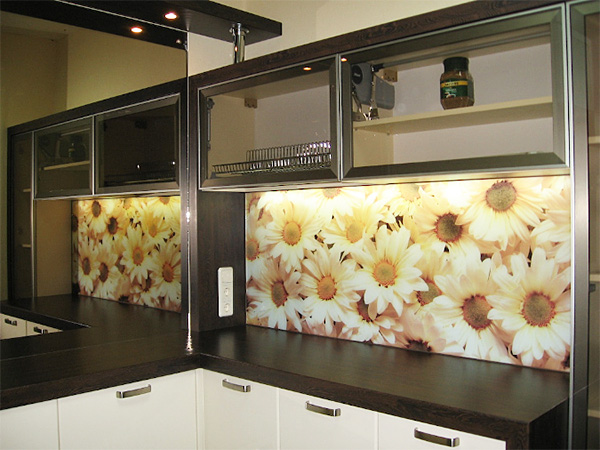
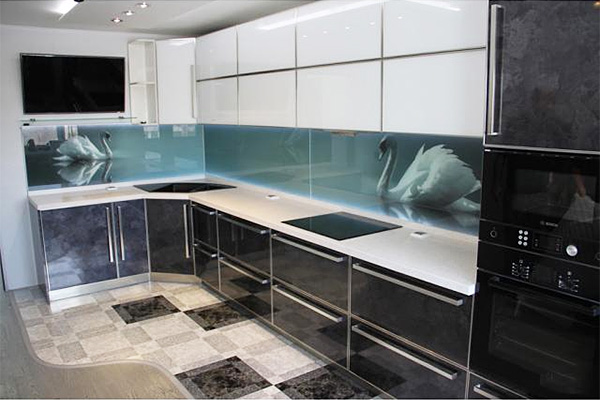
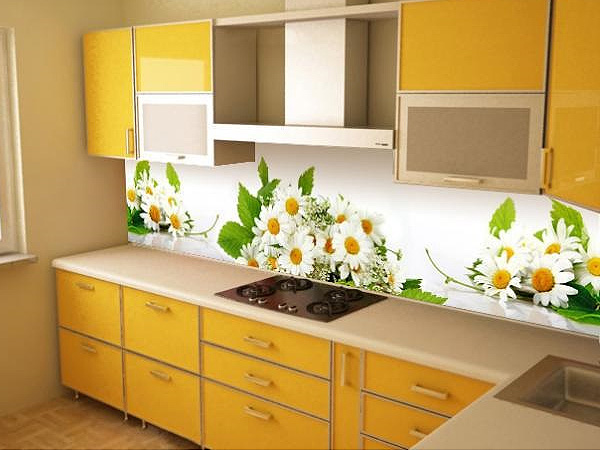
Triplex
The pattern is located between two glued glasses and is protected from influence external environment from all sides. With a strong impact, the triplex does not break, but cracks, since the fragments are held by the film.
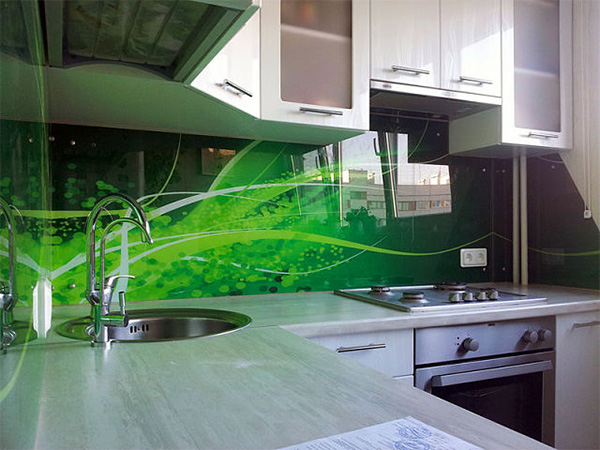

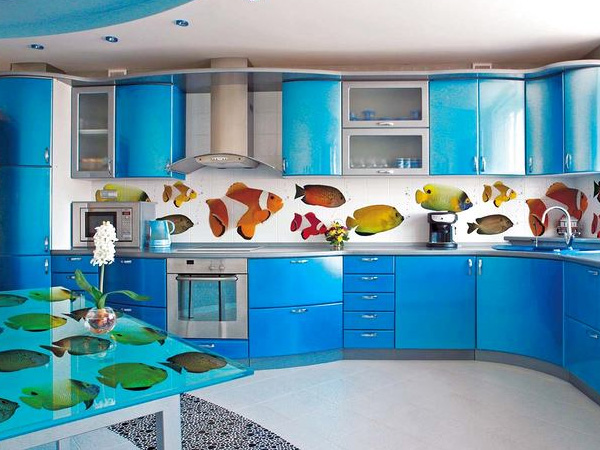
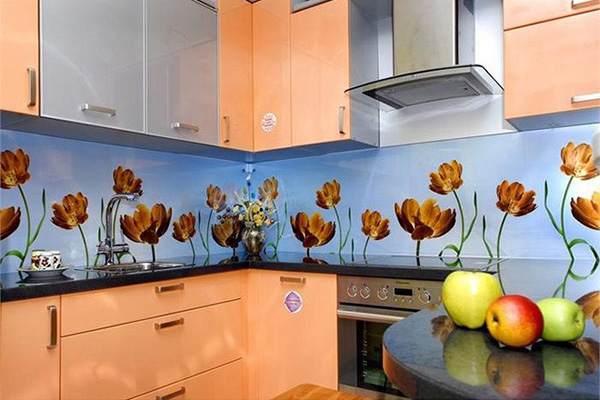
Triplex is quite expensive, it is difficult to make holes for fasteners and sockets in it, so it is rarely used.
Kitchen aprons with photo printing
The image is applied to the back surface using a special technology. The materials used do not fade, last long enough and are not afraid of high temperatures.
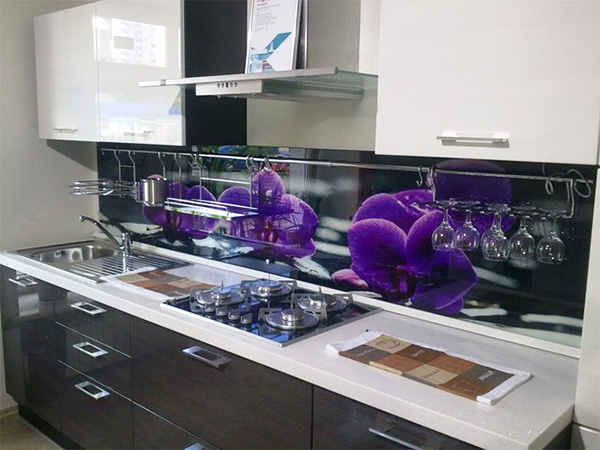
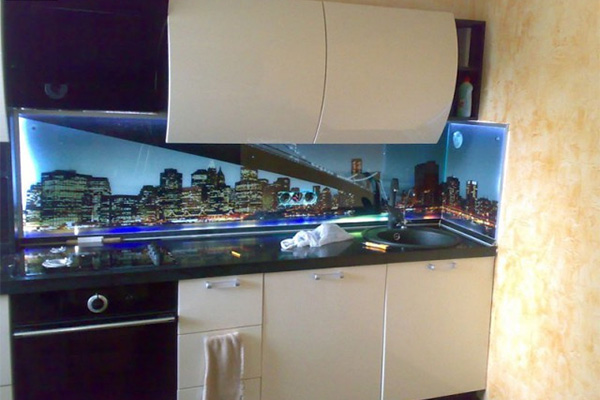
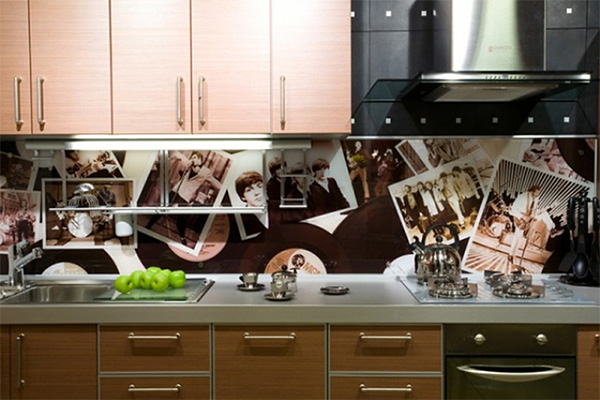
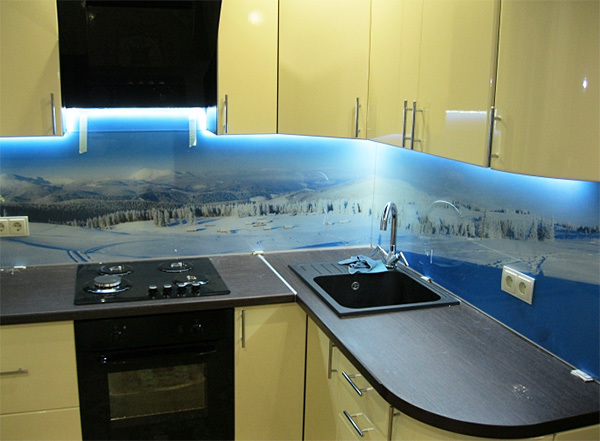
![]()
Panels with photo printing have an elegant appearance and, despite the high cost, are popular. 3D images look especially rich.
![]()

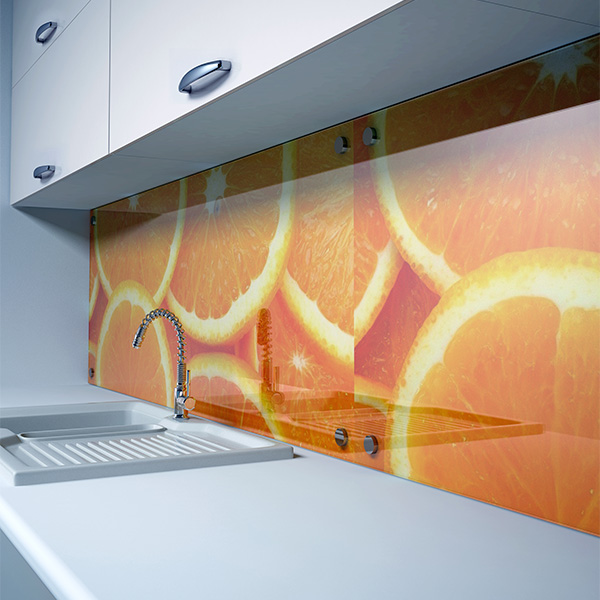
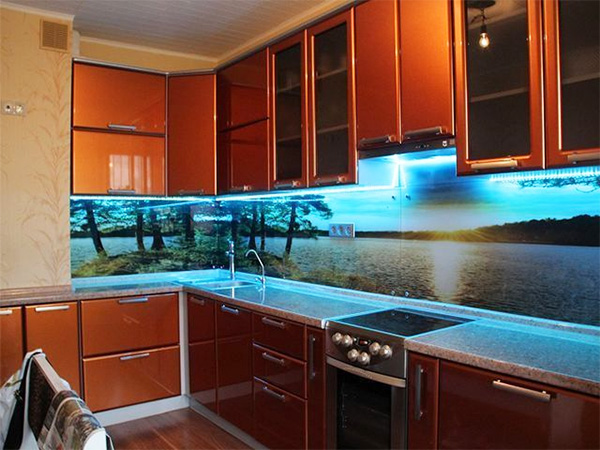

Mirror
Mirror panels visually increase the space and increase the illumination of the room.
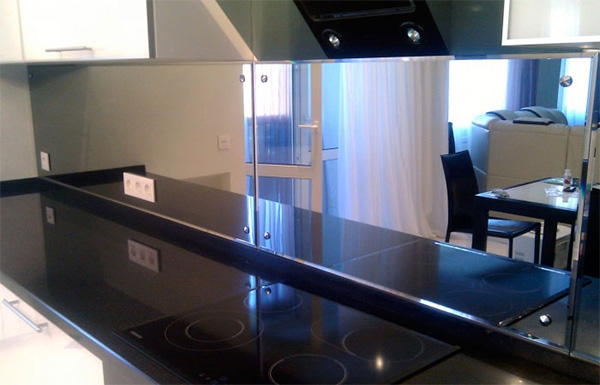
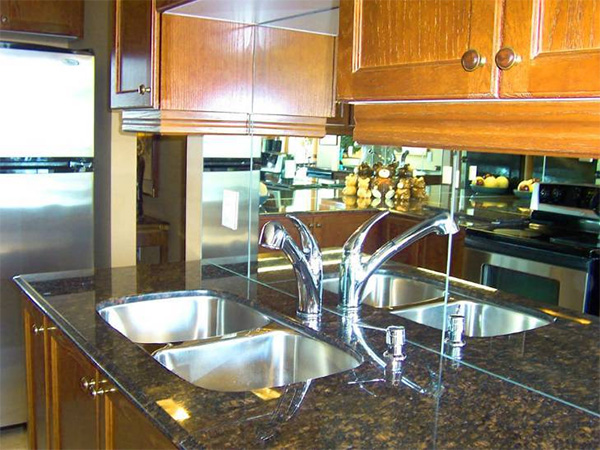
However, many housewives feel uncomfortable constantly seeing their reflection. That's why mirror surface darken or make partially matte.
